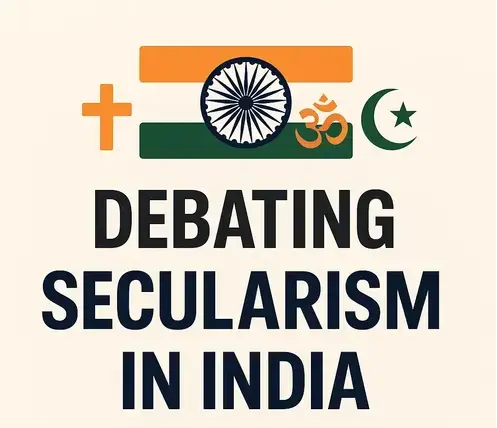
“Secularism in some form is a requirement for the democratic life of religiously diverse societies,” wrote the philosopher Charles Taylor (1998).
India’s religious diversity led to the adoption of secularism to protect freedom of religion and equal treatment of religions. The explicit use of secular was added to the Preamble through the 42nd Constitutional Amendment (1976), which assured a climate of religious tolerance, equal respect and freedom of both believers and non-believers. The Indian Constitution guarantees, through Article 25, the right to freedom of conscience and the right to profess, practice and propagate religion.
However, secularism in India has been a subject of intense debate and distinctive interpretation. The Indian model of secularism, unlike that in Western countries, has suggested a model shifting between dharma-nirpekshata (neutrality toward religions) and sarva-dharma sambhava (the equal respect for all religions). Today, as politics of communal polarization, minority rights, and identity bring attention to issues of secularism, its meaning is contested and research is valuable.
The Concept of Secularism as expounded by Gandhi and Nehru
The question of secularism in India’s struggle for freedom was viewed in two different but complementary light.
(a) Nehru’s Secularism – Dharma-nirpekshata
Jawaharlal Nehru imagined a modern, scientific, and rational state where religion was a private matter and tolerated as long as it was not showy, dependent on one’s upbringing.
Indian historian Bipan Chandra notes that for Nehru, secularism was:
- Separation of religion from political, economic, social, and cultural life.
- Non-affiliation of the State with any religion.
- Full religious freedom for communities.
- Equal opportunities without taking religion into account.
Nehru elaborates on the point that his secularism was not about being against religions but providing neutral respect and response to all religions.
(b) Gandhi’s Secularism – Sarva Dharma Sambhava
As the Mahatma, Gandhi rejected the separation of religions and politics. Rather, he insisted that all religions were equal.
- He was for the role of religion in a person’s life and viewed religions as an instrument for improving an honorable way of life.
- His concept of secularism was about harmony rather than conflict across communities. And, in a plural society, it also led to mass movements to mobilize people.
- Gandhi decried partition, because he called it a “division of hearts,” and his vision for India was for diverse peoples to live peacefully together, whatever their faith.
Therefore, while Nehru emphasized separation and neutrality in his secularism, Gandhi emphasized being inclusive spiritually. In this way, both conceptualizations add to India’s secularism.
Debates of the Constituent Assembly on Secularism
In the Assembly, K.T. Shah, among others, demanded an explicit separation of state and religion and wanted to explicitly include the word “secular”. On the other hand, figures like Tajamul Husain and M. Masani argued that religion needed to be privatized, that is to say religion could no longer inform or act through social or public institutions.
In the end, although the Constitution doesn’t refer to “secular” at all in its original characters, nevertheless the spirit of secularism is captured in Article 25, that guarantees freedom of religion, subject to reasonable limits on public order, morality, and health. Subsequently, the 42nd Amendment (1976) formally included “secularism” in the Preamble.
Anti-Secular Readings: T.N. Madan & Ashis Nandy
Ashis Nandy
- Criticises the Westernized, state-centric notion of Indian secularism, that Nandy argues, is disconnected from traditions of lived tolerance.
- He would suggest that Indian religions have always displayed a version of pluralism and tolerance for each others traditions, but that the secular state has failed to sustain this practice.
- Nandy further distinguishes between religion as faith, or, personal belief and religion as ideology, or, a politicized identity.
- He suggests that the forced exclusion of religion from the public sphere, then, has incited or led to communally motivated action (e.g., Babri Masjid construction, riots at Godhra, CAA debates, etc.).
T.N. Madan
Madan does not outrightly reject secularism, but raises questions about the applicability of secularism to the context of South Asia.
He presents three reasons for the challenges that secularism faces:
- Most people in the region have deep faith and religious commitments.
- Some neighboring countries (Pakistan, Sri Lanka) have declared state religions.
- Secularism is in tension with the growth of religious fundamentalisms.
He indicates that perhaps a Gandhian model of inter-religious respect would be more appropriate than a Nehruvian model of detachment for Indian society.
Marxist Critiques: Akhil Bilgrami and Achin Vanaik
Achin Vanaik
Vanaik is critical of both Nandy and Madan, whom he believes glorify traditional forms of religiosity. For him, these forms are communalism.He writes about secularism as:
- The right to freedom to worship
- Citizenship takes primacy over religious identity
- The state shall have no religious identity
He acknowledges Gandhi’s contribution to secularism but believes that when using the language of religion, it is merely as a tool to mobilize people rather than a current and sustainable secular practice.
Akhil Bilgrami
Bilgrami does not see Nandy’s nostalgic desire for traditional tolerance as being valuable.
- Akhil argues that we must not go back to traditional tolerance, but rather develop new frameworks to fit with modern realities.
- Bilgrami supports Nehruvian secularism because when there are multiple definitions of secularism, it dilutes it as a concept.
- He calls for a unified definition of secularism in order to minimize the ability of communalism to misuse it in the public realm.
Contemporary Importance of Secularism
Secularism is still a charged pillar of Indian democracy. At the present time, the debates revolve around:
- Minority rights in relationship to majoritarian politics.
- State neutrality in relation to the Uniform Civil Code, temple–mosque conflicts, and reservations.
- The growth of identity-based politics that transgresses state neutrality.
The understanding of secularism is now primarily contested ground in battles for ideological supremacy, radically altered from the principle of harmony (sarva dharma sambhava) which puts its survival at stake in India’s plural fabric.
Conclusion
Secularism has always been a subject of debate in India, shaped by Gandhi’s inclusiveness, Nehru’s neutrality, critics amongst intellectuals and a Marxist interpretation. It is true that there are those who believe that secularism is something foreign to India’s civilizational traditions, just as there are those who argue it has nothing to do with its democratic functioning. As Beteille (1994) has put it, the concept of secularism is often limited in our thinking, however, the belief that every civilized state has to be secular is not true.
For India, the challenge is not to abandon secularism but to re-imagine it in the context of the realities of today – when the role of religion continues to shape politics, society and its identity. All of the principles of Indian secularism must retain the objective which balanced the forms of diversity and equality in terms of justice.
FAQs about secularism in India
- When did secularism start in India?
Secularism in India started during the freedom movement, inspired by M.K. Gandhi and Jawaharlal Nehru, and later made into the Constitution as a result of Article 25–28, and the 42nd Amendment introduced in 1976. - How does Indian secularism differ from Western secularism?
Unlike the Western model of separation of church and state, Indian secularism conveys a concept of equal respect among all religions, or ancient terms-the end of the concepts of sarva dharma sambhava, while identifying a neutral State. - What articles of the Constitution are related to secularism?
Articles 25-28 relate to and guarantee freedom of religion, and Articles 14-16 determine equality before the law, and the right to not be discriminated against based on religion. The term “secular” was added in the Preamble in/under the 1976 Amendment. - Who were the key figures of secularism in India?
Jawaharlal Nehru, Mahatma Gandhi, B.R. Ambedkar and the other writers of the Indian Constitution represented the concepts of Indian secularism. - Why is secularism significant in India today?
Secularism is significant about maintaining peace in India’s society of several religions, or preventing the notion of communalism, and creating equality among all regardless of faith.


Informative 👍